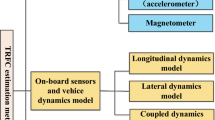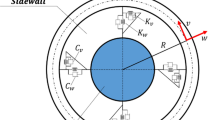Abstract
An accurate estimation of the maximum tire-road friction coefficient may provide higher performance in a vehicle active safety control system. Unfortunately, real-time tire-road friction coefficient estimation is costly and necessitates additional sensors that must be installed and maintained at all times. This paper proposes an advanced longitudinal tire-road friction coefficient estimation method that is capable of considering irregular road surfaces. The proposed algorithm uses a stiffness based estimation method, however, unlike previous studies, improvements were made by suggesting a third order model to solve problems related to nonlinear mu-slip curve. To attain the tire-road friction coefficient, real-time normalized force is obtained from the force estimator as exerted from the tire in the low slip region using the recursive least squares method. The decisive aspect of using the suggested algorithm lies in its low cost and versatility. It can be used under irregular road conditions due to its capability of easily obtaining wheel speed and acceleration values from production cars. The newly improved algorithm has been verified to computer simulations as well as compact size cars on dry asphalt conditions.
Similar content being viewed by others
Abbreviations
- F :
-
tire force, N
- λ x :
-
longitudinal tire slip ratio, −
- V :
-
velocity, km/h
- T o :
-
output shaft torque, Nm
- m s, m u :
-
sprun/unsprung mass, kg
- h :
-
height of the mass center, m
- \(\ddot x_{cg} \) :
-
longitudinal acceleration, m/s2
- l f,r :
-
distance center to front and rear wheels, m
- z s :
-
normal position at the sprung mass, m
- z u :
-
normal position at the un-sprung mass, m
- z r :
-
normal position at the road, m
- b s :
-
damping constant of suspension, Ns/m
- k s :
-
spring constant of suspension, N/m
- S :
-
stiffness, −
- K(t):
-
update gain, −
- P(t):
-
error covariance, −
- λ :
-
forgetting factor, −
- ε s,e :
-
curve fitting trigger/end signal, −
- x, y, z :
-
direction of vehicle longitudinal/lateral/vertical
- ω :
-
wheel
- m :
-
measured value
References
Ahn, C., Peng, H. and Tseng, H. E. (2013). Robust estimation of road frictional coefficient. IEEE Trans. Control Systems Technology 21, 1, 1–13.
Chen, W. and Saif, M. (2006). Unknown input observer design for a class of nonlinear systems: An LMI approach. American Control Conf., IEEE.
Cho, W., Yoon, J., Yim, S., Koo, B. and Yi, K. (2010). Estimation of tire forces for application to vehicle stability control. IEEE Trans. Vehicular Technology 59, 2, 638–649.
Choi, M. and Choi, S. (2014). Model predictive control for vehicle yaw stability with practical concerns. IEEE Trans. Vehicular Technology 63, 8, 3539–3548.
Choi, M. and Choi, S. B. (2013). Estimation of four individual tire forces using limited sensor signals. Int. J. Electrical Energy 1, 2, 108–112.
Choi, M., Oh, J. J. and Choi, S. B. (2013). Linearized recursive least squares methods for real-time identification of tire–Road friction coefficient. IEEE Trans. Vehicular Technology 62, 7, 2906–2918.
Choi, S. B. (2008). Antilock brake system with a continuous wheel slip control to maximize the braking performance and the ride quality. IEEE Trans. Control Systems Technology 16, 5, 996–1003.
Gustafsson, F. (1997). Slip-based tire-road friction estimation. Automatica 33, 6, 1087–1099.
Gustafsson, F. (1998). Monitoring tire-road friction using the wheel slip. Control Systems, IEEE 18, 4, 42–49.
Hahn, J.-O., Rajamani, R. and Alexander, L. (2002). GPSbased real-time identification of tire-road friction coefficient. IEEE Trans. Control Systems Technology 10, 3, 331–343.
Han, K., Choi, S. and Oh, J. (2014). Estimation of vehicle clutch torque using combined sliding mode observers and unknown input observers. Control, Automation and Systems (ICCAS), 14th Int. Conf., IEEE, 1418–1423.
Holzmann, F., Bellino, M., Siegwart, R. and Bubb, H. (2006). Predictive estimation of the road-tire friction coefficient. Computer Aided Control System Design, Int. Conf. Control Applications, Int. Symp. Intelligent Control, IEEE, 885–890.
Hori, Y., Toyoda, Y. and Tsuruoka, Y. (1998). Traction control of electric vehicle: Basic experimental results using the test EV“UOT electric march”. IEEE Trans. Industry Applications 34, 5, 1131–1138.
Ito, M., Yoshioka, K. and Saji, T. (1995). Estimation of road surface conditions using wheel speed behavior. JSAE Review, 16, 221–222.
Kim, C., Hahn, J., Hong, K. and Yoo, W. (2013). Estimation of tire-road friction coefficient based on on-board 6-DoF acceleration measurement. IEEE Trans. Vehicular Technology 64, 8, 3368–3377.
Kim, H., Lee, S. and Hedrick, J. (2015). Active yaw control for handling performance improvement by using traction force. Int. J. Automotive Technology 16, 3, 457–464.
Lee, C., Hedrick, K. and Yi, K. (2004). Real-time slipbased estimation of maximum tire-road friction coefficient. IEEE/ASME Trans. Mechatronics 9, 2, 454–458.
Lian, Y., Zhao, Y., Hu, L. and Tian, Y. (2015). Cornering stiffness and sideslip angle estimation based on simplified lateral dynamic models for four-in-wheelmotor-driven electric vehicles with lateral tire force information. Int. J. Automotive Technology 16, 4, 669–683.
Muller, S., Uchanski, M. and Hedrick, K. (2003). Estimation of the maximum tire-road friction coefficient. J. Dynamic Systems, Measurement, and Control 125, 4, 607–617.
Munson, B. R., Young, D. F. and Okiishi, T. H. (1990). Fundamentals of Fluid Mechanics. John Wiley & Sons. New York.
Nam, K., Oh, S. and Hori, Y. (2010). Robust yaw stability control for electric vehicles based on active steering control. Vehicle Power and Propulsion Conf. (VPPC), IEEE, 1–5.
Oh, J. J. and Choi, S. B. (2012). Vehicle velocity observer design using 6-d imu and multiple-observer approach. IEEE Trans. Intelligent Transportation Systems 13, 4, 1865–1879.
Pacejka, H. (2005). Tire and Vehicle Dynamics. Elsevier. USA.
Paleologu, C., Benesty, J. and Ciochina, S. (2008). A robust variable forgetting factor recursive least-squares algorithm for system identification. Signal Processing Letters, IEEE, 15, 597–600.
Rajamani, R. (2011). Vehicle Dynamics and Control. Springer Science & Business Media. New York.
Rajamani, R., Phanomchoeng, G., Piyabongkarn, D. and Lew, J. Y. (2012). Algorithms for real-time estimation of individual wheel tire-road friction coefficients. IEEE/ASME Trans. Mechatronics 17, 6, 1183–1195.
Ray, L. R. (1997). Nonlinear tire force estimation and road friction identification: simulation and experiments. Automatica 33, 10, 1819–1833.
Sato, Y., Kobayashi, D., Watanabe, K., Watanabe, K., Kuriyagawa, Y. and Kuriyagawa, Y. (2007). Study on recognition method for road friction condition. JSAE Trans., 38, 51–56.
Sierra, C., Tseng, E., Jain, A. and Peng, H. (2006). Cornering stiffness estimation based on vehicle lateral dynamics. Vehicle System Dynamics, 44, 24–38.
Wang, J., Alexander, L. and Rajamani, R. (2004). Friction estimation on highway vehicles using longitudinal measurements. J. Dynamic Systems, Measurement, and Control 126, 2, 265–275.
Yoon, J., Cho, W., Koo, B. and Yi, K. (2009). Unified chassis control for rollover prevention and lateral stability. IEEE Trans. Vehicular Technology 58, 2, 596–609.
You, S.-H., Hahn, J.-O. and Lee, H. (2009). New adaptive approaches to real-time estimation of vehicle sideslip angle. Control Engineering Practice 17, 12, 1367–1379.
Author information
Authors and Affiliations
Corresponding author
Rights and permissions
About this article
Cite this article
Han, K., Hwang, Y., Lee, E. et al. Robust estimation of maximum tire-road friction coefficient considering road surface irregularity. Int.J Automot. Technol. 17, 415–425 (2016). https://doi.org/10.1007/s12239-016-0043-8
Received:
Revised:
Accepted:
Published:
Issue Date:
DOI: https://doi.org/10.1007/s12239-016-0043-8




